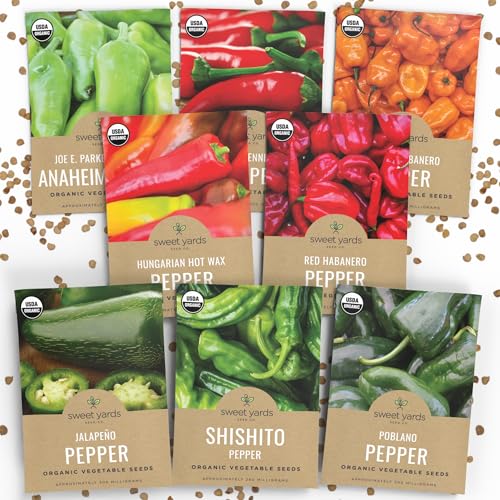Did you know that Americans consume over 20 pounds of peppers per person annually? From the mild bell pepper gracing our salads to the fiery Carolina Reaper challenging our taste buds, peppers have become an essential ingredient in American kitchens – and a rewarding crop for home gardeners.
Whether you’re a backyard gardening enthusiast looking to spice up your harvest or a small-scale farmer exploring profitable specialty crops, this comprehensive guide will walk you through everything you need to know about growing peppers successfully in American growing conditions.
What Makes Peppers Special? Understanding the Capsicum Family
Peppers belong to the Capsicum genus, with over 3,000 varieties ranging from sweet bell peppers to superhot Carolina Reapers. These versatile plants are actually fruits (botanically berries), packed with vitamins A and C, antioxidants, and the famous compound capsaicin that gives them their heat.
The heat level in peppers is measured using the Scoville Heat Unit (SHU) scale, developed by American pharmacist Wilbur Scoville in 1912. This scale ranges from 0 SHU for bell peppers to over 2 million SHU for the hottest varieties.
The American Pepper Market
The U.S. pepper market is valued at over $1.5 billion annually, with growing demand for specialty varieties driving premium prices. According to USDA data, specialty peppers can command $3-8 per pound at farmers markets, compared to $1-2 for common varieties.
Types of Peppers: From Sweet to Superhot
Sweet Peppers (0-100 SHU)
Bell Peppers
- Heat level: 0 SHU
- Uses: Salads, stuffing, grilling, raw snacking
- Growing notes: Require warm weather, 70+ days to maturity
- Market value: $2-4 per pound at farmers markets
Italian Sweet Peppers
- Heat level: 0-100 SHU
- Uses: Roasting, sautéing, Italian cuisine
- Growing notes: Productive plants, excellent for containers
- Market value: $3-5 per pound specialty varieties
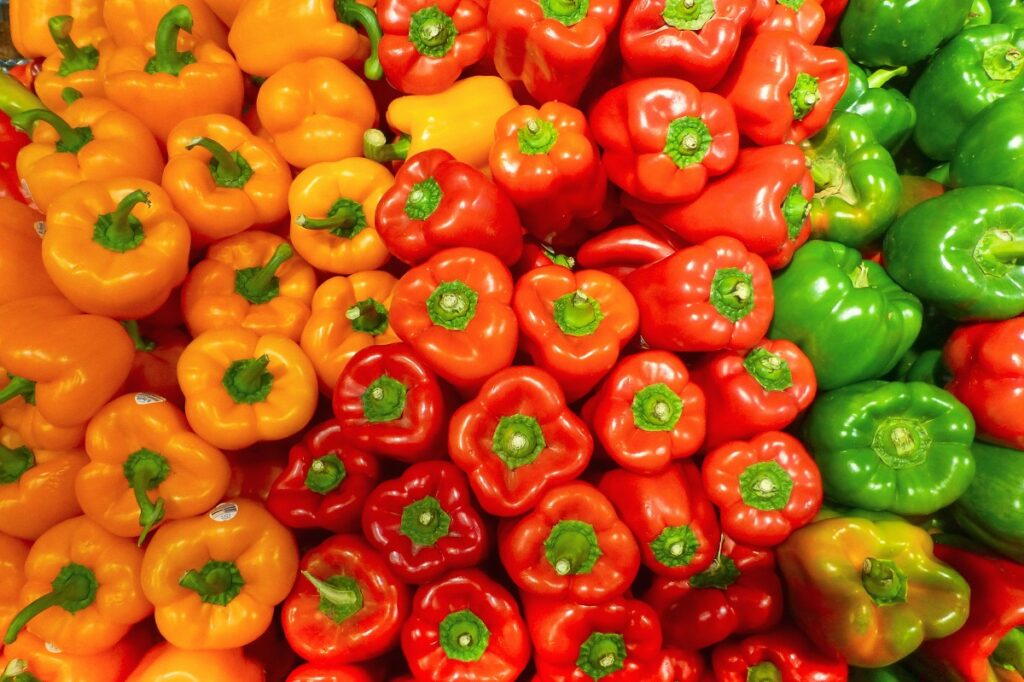
Mild Heat Peppers (100-8,000 SHU)
Poblano/Ancho Peppers
- Heat level: 1,000-2,000 SHU
- Uses: Stuffing (chiles rellenos), drying, Mexican cuisine
- Growing notes: Large plants need support, 75-85 days
- Market demand: High in Southwest markets
Jalapeño Peppers
- Heat level: 2,500-8,000 SHU
- Uses: Fresh salsa, pickling, nachos, smoking (chipotle)
- Growing notes: Extremely productive, suitable for succession planting
- Commercial value: One of America’s most popular peppers
Medium Heat Peppers (8,000-100,000 SHU)
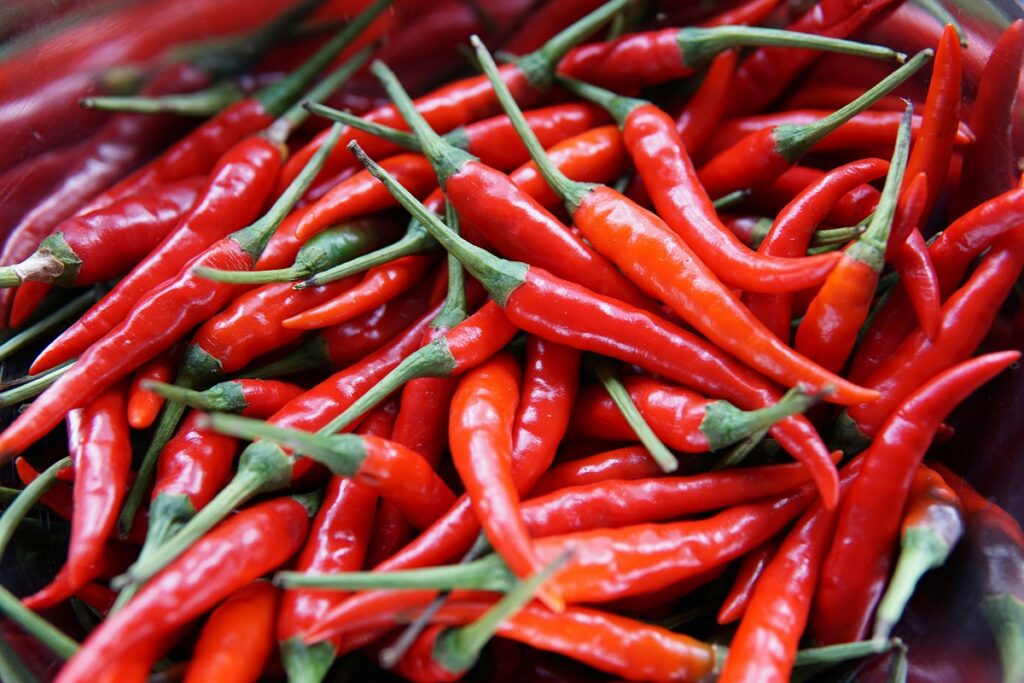
Serrano Peppers
- Heat level: 10,000-25,000 SHU
- Uses: Hot sauces, fresh salsas, Thai cuisine
- Growing notes: Compact plants, excellent for containers
- Storage: Freezes well whole for year-round use
Cayenne Peppers
- Heat level: 30,000-50,000 SHU
- Uses: Drying, hot sauce production, medicinal preparations
- Growing notes: Long, thin fruits perfect for dehydrating
- Processing: Excellent for making pepper powder
Hot Peppers (100,000+ SHU)
Habanero Peppers
- Heat level: 100,000-350,000 SHU
- Uses: Gourmet hot sauces, Caribbean cuisine
- Growing notes: Requires consistent warmth, longer season
- Safety note: Handle with gloves to prevent skin irritation
Ghost Peppers (Bhut Jolokia)
- Heat level: 855,000-1,041,427 SHU
- Uses: Extreme hot sauce production, novelty crops
- Growing notes: Slow germination, requires very warm conditions
- Market niche: Premium prices for superhot varieties
Step-by-Step Pepper Growing Guide
Step 1: Planning and Site Selection
Climate Requirements:
- Soil temperature: 65-75°F for germination
- Air temperature: 70-85°F during growing season
- Growing season: 100-120 frost-free days minimum
- Sunlight: 6-8 hours direct sunlight daily
Site Selection Criteria:
- Well-drained soil with pH 6.0-7.0
- Protection from strong winds
- Good air circulation to prevent disease
- Easy access for maintenance and harvesting
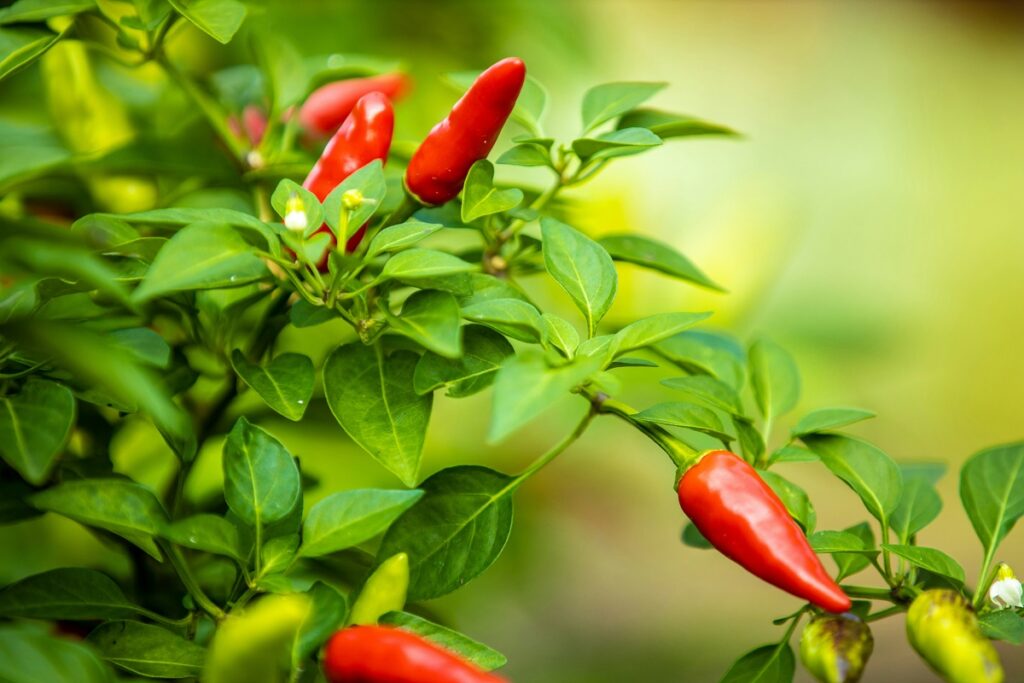
Step 2: Soil Preparation and Amendments
Soil Testing: Conduct soil tests to determine pH, nutrient levels, and organic matter content. Most extension offices provide affordable testing services.
Soil Amendment Recipe:
- Base soil: Well-draining garden soil or quality potting mix
- Compost: 25-30% by volume for nutrient addition
- Perlite or coarse sand: 10-15% for drainage improvement
- Organic fertilizer: 2-3 pounds per 100 square feet
Container Growing Mix:
- 40% quality potting soil
- 30% compost or aged manure
- 20% perlite or vermiculite
- 10% coarse sand or bark chips
Step 3: Starting Seeds vs. Transplants
Seed Starting (8-10 weeks before last frost):
Indoor Setup:
- Temperature: Maintain 75-85°F for germination
- Lighting: 14-16 hours under grow lights daily
- Humidity: 60-70% relative humidity
- Containers: Use seed starting trays or small pots
Germination Timeline:
- Sweet peppers: 7-14 days
- Hot peppers: 14-21 days
- Superhots: 21-30+ days
Transplant Option: Purchase healthy transplants from reputable nurseries. Look for stocky plants with dark green foliage and no signs of disease or pests.
Step 4: Transplanting and Garden Setup
Timing:
- Soil temperature consistently above 60°F
- 2-3 weeks after last frost date
- Nighttime temperatures stay above 50°F
Planting Spacing:
- Small varieties: 12-18 inches apart
- Medium varieties: 18-24 inches apart
- Large varieties: 24-36 inches apart
- Row spacing: 30-36 inches
Hardening Off Process: Gradually acclimate seedlings to outdoor conditions over 7-10 days before transplanting.
Step 5: Ongoing Care and Maintenance
Watering Strategy:
- Consistent moisture without waterlogging
- 1-1.5 inches per week including rainfall
- Water at soil level to prevent foliar diseases
- Mulch to retain moisture and suppress weeds
Fertilization Schedule:
- Pre-plant: Incorporate balanced organic fertilizer
- Early growth: Light nitrogen application
- Flowering: Reduce nitrogen, increase phosphorus/potassium
- Fruiting: Consistent feeding every 2-3 weeks
Support Systems:
- Stake tall varieties early in the season
- Use tomato cages for bushy varieties
- Tie plants gently with soft materials
- Provide wind protection in exposed areas
Step 6: Pest and Disease Management
Common Pests:
- Aphids: Use insecticidal soap or beneficial insects
- Hornworms: Hand-pick or use Bt (Bacillus thuringiensis)
- Flea beetles: Row covers during early growth
- Spider mites: Maintain humidity, use predatory mites
Disease Prevention:
- Proper spacing for air circulation
- Avoid overhead watering
- Crop rotation (don’t follow tomatoes/potatoes)
- Remove plant debris at season end
Organic Treatment Options:
- Neem oil for various pests and diseases
- Copper-based fungicides for bacterial issues
- Companion planting with basil, marigolds
- Beneficial insect habitat creation
Step 7: Harvesting and Post-Harvest Handling
Harvest Timing:
- Green peppers: Harvest when full-size but immature
- Ripe peppers: Allow color change for maximum flavor
- Hot peppers: Peak heat when fully mature
- Continuous harvest: Pick regularly to encourage production
Harvesting Technique:
- Use clean, sharp scissors or pruners
- Cut stem ¼ inch above pepper
- Handle hot varieties with gloves
- Harvest in cool morning hours when possible
Storage Options:
- Fresh: Refrigerate 1-2 weeks in crisper drawer
- Freezing: Whole or chopped, blanching optional
- Dehydrating: Slice thin and dry until crisp
- Pickling: Preserve in vinegar solutions
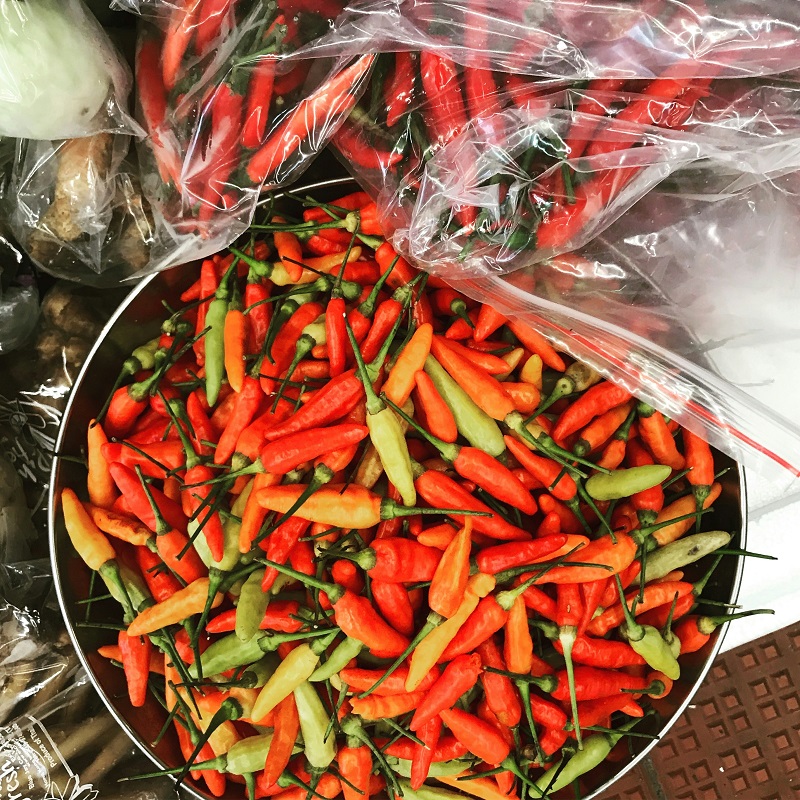
Regional Growing Considerations
Northern States (Zones 3-6)
Challenges:
- Short growing season
- Cool summer temperatures
- Early fall frosts
Solutions:
- Start seeds early indoors
- Use season extenders (row covers, cold frames)
- Select shorter-season varieties
- Container growing for mobility
Southern States (Zones 8-10)
Advantages:
- Long growing season
- Suitable for multiple successions
- Can grow superhot varieties successfully
Considerations:
- Extreme heat stress management
- Increased pest and disease pressure
- Irrigation crucial during summer
Southwest (Zones 7-9)
Ideal Conditions:
- Hot, dry climate perfect for peppers
- Traditional pepper-growing region
- Strong market demand for varieties
Water Management:
- Drip irrigation systems recommended
- Shade cloth during extreme heat
- Soil moisture conservation critical
Container Growing for Small Spaces
Container Selection
Size Requirements:
- Small peppers: 3-5 gallon containers minimum
- Medium peppers: 5-7 gallon containers
- Large peppers: 7-10+ gallon containers
- Drainage: Multiple holes essential
Material Options:
- Plastic: Lightweight, affordable, retain moisture
- Ceramic: Attractive, heavy, good insulation
- Fabric: Excellent drainage, air pruning roots
- Wood: Natural look, requires treatment
Container Growing Benefits
Advantages:
- Mobility for sun tracking and weather protection
- Better soil control and drainage
- Earlier and later season growing
- Suitable for patios, balconies, small yards
Management Considerations:
- More frequent watering required
- Regular fertilization necessary
- Wind protection important
- Winter storage for perennial growing
Value-Added Opportunities
Direct Sales and Marketing
Farmers Market Success:
- Focus on unique, colorful varieties
- Provide heat level information and uses
- Offer value-added products (hot sauce, pickles)
- Build customer relationships and repeat business
Specialty Restaurant Sales:
- Develop relationships with local chefs
- Grow varieties specifically requested
- Provide consistent, high-quality products
- Premium pricing for fresh, local peppers
Processing and Value Addition
Hot Sauce Production:
- Cottage food laws vary by state
- Require proper pH testing and processing
- Strong profit margins on finished products
- Growing market for artisanal hot sauces
Dehydrated Products:
- Pepper powders and flakes
- Long shelf life and concentrated flavor
- Higher value per pound than fresh
- Popular with gourmet cooks and restaurants
Agritourism Integration
Farm Tours and Education:
- Pepper variety demonstrations
- Heat tolerance challenges (safely managed)
- Educational workshops on growing and processing
- Additional revenue streams for farm operations
Health Benefits and Culinary Uses
Nutritional Value
Vitamin Content:
- Vitamin C: Higher than citrus fruits
- Vitamin A: Especially in red varieties
- Antioxidants: Carotenoids and flavonoids
- Capsaicin: Anti-inflammatory properties
Health Benefits:
- Metabolism boosting effects
- Pain relief applications
- Cardiovascular health support
- Weight management assistance
Culinary Applications
Fresh Uses:
- Salads and raw preparations
- Stir-fries and sautéed dishes
- Grilling and roasting applications
- Fresh salsa and relish making
Preservation Methods:
- Pickling in vinegar solutions
- Fermentation for hot sauce production
- Dehydrating for spice powders
- Freezing whole or processed
Technology and Innovation in Pepper Production
Precision Agriculture Applications
Climate Control:
- Greenhouse automation systems
- Temperature and humidity monitoring
- Automated irrigation scheduling
- LED lighting for season extension
Data Collection:
- Growth tracking applications
- Yield monitoring systems
- Weather station integration
- Soil sensor networks
Sustainable Production Practices
Integrated Pest Management:
- Beneficial insect releases
- Pheromone trapping systems
- Biological control agents
- Reduced pesticide applications
Water Conservation:
- Drip irrigation systems
- Soil moisture monitoring
- Mulching for water retention
- Rainwater collection systems
Common Problems and Solutions
Growing Challenges
Problem: Slow germination of hot pepper seeds Solution: Maintain consistent 80-85°F temperature and consider pre-soaking seeds
Problem: Blossom end rot in developing fruits Solution: Ensure consistent watering and adequate calcium availability
Problem: Low fruit set despite flowering Solution: Hand-pollinate flowers or improve growing conditions for natural pollinators
Quality Issues
Problem: Mild heat in supposedly hot varieties Solution: Stress plants slightly with reduced watering and ensure full maturity
Problem: Cracked or split fruits Solution: Maintain consistent soil moisture and avoid overwatering
Problem: Poor flavor development Solution: Allow full ripening and provide adequate sunlight and nutrition
Economic Analysis and Profitability
Production Costs (per 100 plants)
Initial Investment:
- Seeds/transplants: $25-50
- Containers (if needed): $200-400
- Soil amendments: $30-50
- Support materials: $25-40
- Total startup: $280-540
Annual Operating Costs:
- Fertilizer: $20-30
- Water: $15-25
- Pest control: $10-20
- Annual operations: $45-75
Revenue Potential
Fresh Sales:
- Common varieties: $3-5 per pound
- Specialty varieties: $5-10 per pound
- Superhot varieties: $10-20 per pound
- Average yield: 2-5 pounds per plant
Value-Added Products:
- Hot sauce: $8-15 per 5oz bottle
- Dried peppers: $15-25 per pound
- Pickled peppers: $6-12 per jar
Future Trends and Opportunities
Market Developments
Growing Demand:
- Specialty and heirloom varieties
- Organic and sustainable production
- Local and farm-to-table movements
- International cuisine popularity
Technology Integration:
- Smart farming applications
- Automated harvest systems
- Blockchain traceability
- Direct-to-consumer platforms
Breeding and Variety Development
New Varieties:
- Disease-resistant cultivars
- Climate-adapted selections
- Novel flavor profiles
- Extended shelf-life varieties
Breeding Goals:
- Higher yields and quality
- Improved stress tolerance
- Enhanced nutritional content
- Unique market characteristics
Conclusion: Growing Success with Peppers
Peppers offer one of the most rewarding and profitable opportunities for both home gardeners and commercial growers in American agriculture. From the satisfaction of harvesting your first homegrown jalapeño to building a successful specialty pepper business, these versatile plants provide endless possibilities.
Success with pepper cultivation comes down to understanding the fundamentals: proper variety selection, optimal growing conditions, consistent care, and appropriate harvesting techniques. Whether you’re growing a few plants in containers on your patio or managing acres of specialty varieties for commercial sales, the principles remain the same.
The American pepper market continues to evolve, driven by increasing interest in diverse cuisines, health-conscious consumers, and the farm-to-table movement. Growers who focus on quality, unique varieties, and sustainable practices will find eager markets for their products.
Start with varieties suited to your climate and experience level, learn from each growing season, and gradually expand your knowledge and production. The combination of relatively simple growing requirements, high value per square foot, and strong market demand makes peppers an excellent choice for both beginning and experienced growers.
Remember that pepper growing is both an art and a science. While the fundamentals provide your foundation, each growing season brings new learning opportunities and chances to refine your techniques. Embrace the process, enjoy the harvest, and share the spicy goodness with your community.
Ready to start your pepper growing journey? What varieties are you most excited to try, and what growing challenges do you face in your region? Share your pepper growing plans in the comments below, and don’t forget to check out our companion article on “Building Soil Health for Maximum Vegetable Production” to optimize your growing foundation.


